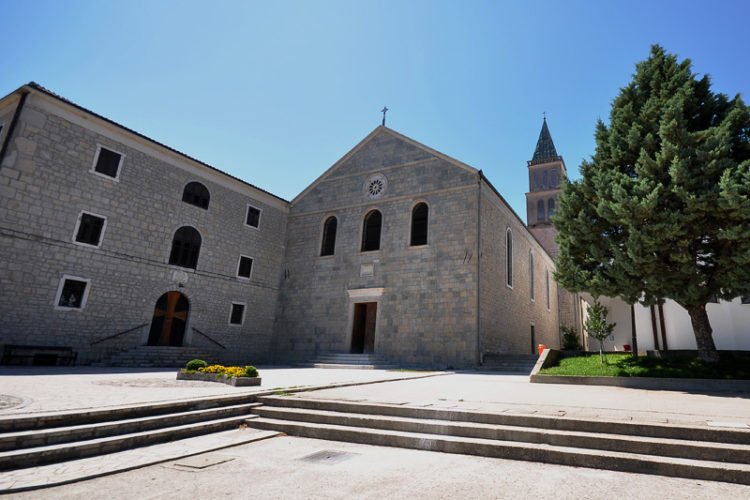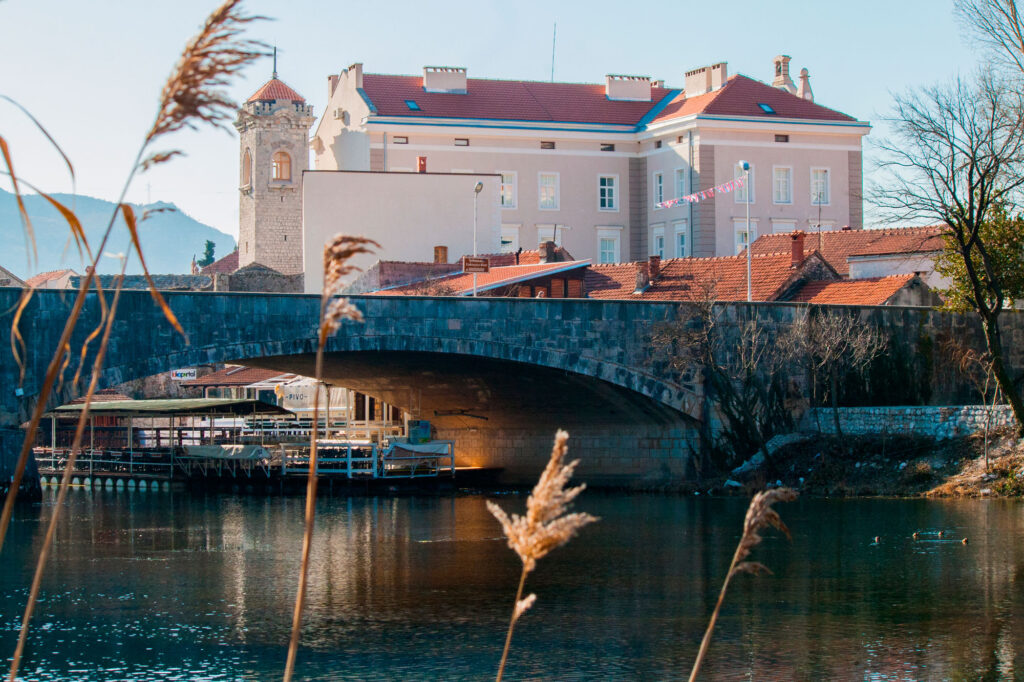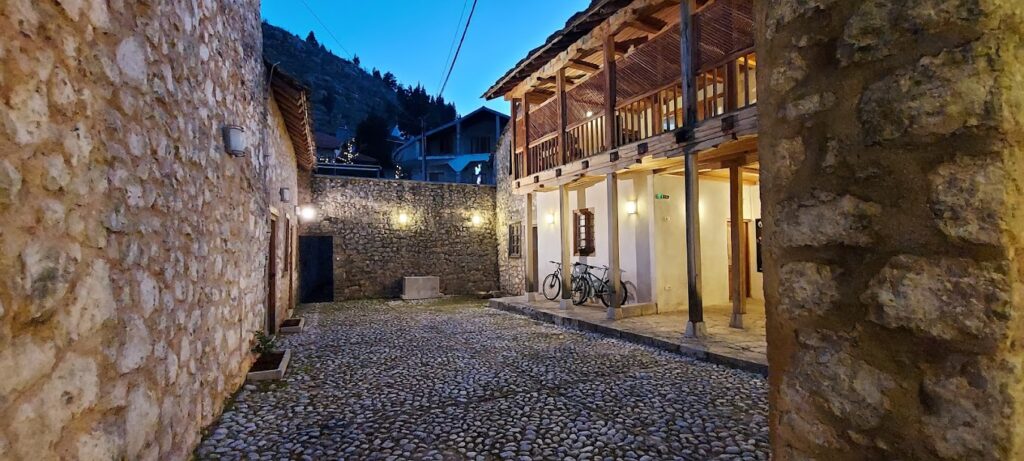HWR
Gallery

Museum Humac
The Franciscan Monastery in Humac contains the oldest museum in Bosnia and Herzegovina, founded in 1884. The museum displays Humac Stone Tablet from XII. Century which is the oldest preserved monument written in Croatian (a mixture of Glagolitic and Old Croatian Cyrillic). Thanks to the collecting activities of numerous Franciscans, as well as various donations from the civilian population, the holdings were continuously increasing, as was the need for new premises for the archaeological collection. Today’s museum exhibition, founded in 2003, is located in the basement of the monastery of St. Anthony of Padua on Humac. Archaeological material was collected in the wider area of Herzegovina and divided into prehistoric, ancient and medieval in a time span of almost 16,000 years. Part of the complex is a lapidary for the exhibition of stone monuments located in the monastery courtyard. Around 70 Roman monuments were found in the area of the Ljubuški region, of which the largest number are tombstones (stelae) belonging to veterans and soldiers of various legionary and auxiliary units. The museum displays the oldest Cyrillic-Glagolitic monument, which retells the restoration of the church of the Archangel Michael in the period 11/12. century, popularly called “Humac Stone Tablet”. Humac Stone Tablet is the oldest written monument of Croats in BiH.
Opening times: everyday from 10:00 am to 7:00 pm

Museum of Herzegovina
The museum was created as a result of the idea of the most famous Trebinje resident, poet and diplomat, Jovan Dučić . It was founded in 1952. The first archaeological excavation was carried out by the museum in 1957 at the church of St. Peter in Zavala. The first publication, entitled Trebinje I , was published by Vasilija Korać in 1966. In 1975, he started the Tribunija magazine . It has about 1,500 m² of useful space, of which about 800 m² is exhibition space. As part of the Museum of Herzegovina, there is also a branch in Ušće (Lastva), a legacy of Dubravka Kujačić , where occasional exhibitions, promotions, and concerts are organized. The museum also has a significant collection of library materials (library with specialist books from various fields of science, culture and art).

Šarić House – Branko Šotra Gallery
The Šarić House, also known as Branko Šotra Gallery, is situated near Čaršija, the main crossroads of trade and travel in Stolac. Built in 1734/1735, the Šarić family, a prominent Muslim family in the region, was associated with this historical building. Ismail-kapetan, a notable member of the family, contributed significantly to the town’s development by constructing a mosque, school, cistern, and shops. In 1963, the Art Gallery in Sarajevo established its first external branch in Stolac and named it after Branko Šotra, a renowned print artist from the former Yugoslavia, who was born in Stolac. The gallery housed 92 prints donated by Šotra, forming a permanent exhibition. His artwork featured striking black and white contrasts, portraying World War II events in his early works and later shifting focus to Herzegovinian landscapes and people.

The Hub of Fine Arts
The Hub of Fine Arts is a unique intersection of modernist stylistic expression and the greatest artists of the first half of the twentieth century. More than 100 exhibits offer excellent insight into the constants and revolutionary aspects of these artworks, revealing all the uniqueness of an age and this potential is the reference point for the creation of a museum exhibit concept. The Hub of Fine Arts offers a multidimensional art and culture experience to visitors of all ages, and, with the help of the latest museum tools, educates them on the creative process of art and recent cultural currents. As a unique art space in the region, The Hub of Fine Arts will showcase its uniqueness through quality art exhibitions focusing on the works of international masters of modernism.

The Mak Dizdar House
Mak Dizdar, born on October 17, 1917, in Stolac, is considered one of the greatest poets of Bosnia and Herzegovina. He spent most of his life in Sarajevo, where he passed away on the 14th of July, 1971. In 1966, he published the poetry book “Stone Sleeper,” which is regarded as the pinnacle of his entire literary work and one of the foundational pieces of literature in Bosnia and Herzegovina. Towards the end of his life, Dizdar wished to return to his hometown, but his desire was never fulfilled. However, in 1997, on the occasion of the 90th anniversary of his birth, the descendants of Mak Dizdar, gathered around the Mak Dizdar Foundation, decided to posthumously fulfill his wish and build the Mak House, a museum and gallery center dedicated to his life and work. The Mak House is not the birthplace or grave of Mak Dizdar; rather, it is conceived as something more subtle: a place where Mak’s spirit resides, living through his manuscripts, books, notes, as well as every poem and word he wrote. Moreover, due to Mak’s connection with the stećak, the Mak House also serves as a home for the art of the stećak. This includes not only scholarly works about the stećak and medieval Bosnia in the library of the Mak House but also art inspired by these unique medieval standing stones.

Museum Humac
The Franciscan Monastery in Humac contains the oldest museum in Bosnia and Herzegovina, founded in 1884. The museum displays Humac Stone Tablet from XII. Century which is the oldest preserved monument written in Croatian (a mixture of Glagolitic and Old Croatian Cyrillic). Thanks to the collecting activities of numerous Franciscans, as well as various donations from the civilian population, the holdings were continuously increasing, as was the need for new premises for the archaeological collection. Today’s museum exhibition, founded in 2003, is located in the basement of the monastery of St. Anthony of Padua on Humac. Archaeological material was collected in the wider area of Herzegovina and divided into prehistoric, ancient and medieval in a time span of almost 16,000 years. Part of the complex is a lapidary for the exhibition of stone monuments located in the monastery courtyard. Around 70 Roman monuments were found in the area of the Ljubuški region, of which the largest number are tombstones (stelae) belonging to veterans and soldiers of various legionary and auxiliary units. The museum displays the oldest Cyrillic-Glagolitic monument, which retells the restoration of the church of the Archangel Michael in the period 11/12. century, popularly called “Humac Stone Tablet”. Humac Stone Tablet is the oldest written monument of Croats in BiH.
Opening times: everyday from 10:00 am to 7:00 pm

Museum of Herzegovina
The museum was created as a result of the idea of the most famous Trebinje resident, poet and diplomat, Jovan Dučić . It was founded in 1952. The first archaeological excavation was carried out by the museum in 1957 at the church of St. Peter in Zavala. The first publication, entitled Trebinje I , was published by Vasilija Korać in 1966. In 1975, he started the Tribunija magazine . It has about 1,500 m² of useful space, of which about 800 m² is exhibition space. As part of the Museum of Herzegovina, there is also a branch in Ušće (Lastva), a legacy of Dubravka Kujačić , where occasional exhibitions, promotions, and concerts are organized. The museum also has a significant collection of library materials (library with specialist books from various fields of science, culture and art).

Museum Humac
The Franciscan Monastery in Humac contains the oldest museum in Bosnia and Herzegovina, founded in 1884. The museum displays Humac Stone Tablet from XII. Century which is the oldest preserved monument written in Croatian (a mixture of Glagolitic and Old Croatian Cyrillic). Thanks to the collecting activities of numerous Franciscans, as well as various donations from the civilian population, the holdings were continuously increasing, as was the need for new premises for the archaeological collection. Today’s museum exhibition, founded in 2003, is located in the basement of the monastery of St. Anthony of Padua on Humac. Archaeological material was collected in the wider area of Herzegovina and divided into prehistoric, ancient and medieval in a time span of almost 16,000 years. Part of the complex is a lapidary for the exhibition of stone monuments located in the monastery courtyard. Around 70 Roman monuments were found in the area of the Ljubuški region, of which the largest number are tombstones (stelae) belonging to veterans and soldiers of various legionary and auxiliary units. The museum displays the oldest Cyrillic-Glagolitic monument, which retells the restoration of the church of the Archangel Michael in the period 11/12. century, popularly called “Humac Stone Tablet”. Humac Stone Tablet is the oldest written monument of Croats in BiH.
Opening times: everyday from 10:00 am to 7:00 pm

Museum of Herzegovina
The museum was created as a result of the idea of the most famous Trebinje resident, poet and diplomat, Jovan Dučić . It was founded in 1952. The first archaeological excavation was carried out by the museum in 1957 at the church of St. Peter in Zavala. The first publication, entitled Trebinje I , was published by Vasilija Korać in 1966. In 1975, he started the Tribunija magazine . It has about 1,500 m² of useful space, of which about 800 m² is exhibition space. As part of the Museum of Herzegovina, there is also a branch in Ušće (Lastva), a legacy of Dubravka Kujačić , where occasional exhibitions, promotions, and concerts are organized. The museum also has a significant collection of library materials (library with specialist books from various fields of science, culture and art).

Šarić House – Branko Šotra Gallery
The Šarić House, also known as Branko Šotra Gallery, is situated near Čaršija, the main crossroads of trade and travel in Stolac. Built in 1734/1735, the Šarić family, a prominent Muslim family in the region, was associated with this historical building. Ismail-kapetan, a notable member of the family, contributed significantly to the town’s development by constructing a mosque, school, cistern, and shops. In 1963, the Art Gallery in Sarajevo established its first external branch in Stolac and named it after Branko Šotra, a renowned print artist from the former Yugoslavia, who was born in Stolac. The gallery housed 92 prints donated by Šotra, forming a permanent exhibition. His artwork featured striking black and white contrasts, portraying World War II events in his early works and later shifting focus to Herzegovinian landscapes and people.